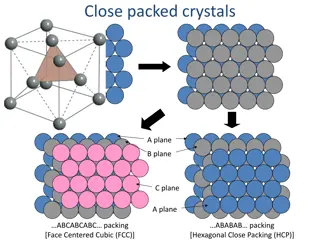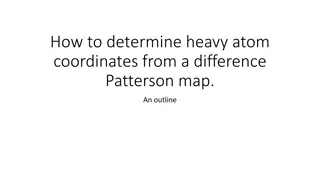
Understanding Crystallography and Crystal Symmetry
Explore the fascinating world of crystallography, where crystals are polyhedral solids with defined geometric shapes and symmetrical arrangements of atoms or molecules. Learn about the parts of a crystal, crystallographic axes, crystal symmetry involving planes and axes of symmetry, and crystal systems classified based on the length and intersection of crystallographic axes.
Download Presentation

Please find below an Image/Link to download the presentation.
The content on the website is provided AS IS for your information and personal use only. It may not be sold, licensed, or shared on other websites without obtaining consent from the author. If you encounter any issues during the download, it is possible that the publisher has removed the file from their server.
You are allowed to download the files provided on this website for personal or commercial use, subject to the condition that they are used lawfully. All files are the property of their respective owners.
The content on the website is provided AS IS for your information and personal use only. It may not be sold, licensed, or shared on other websites without obtaining consent from the author.
E N D
Presentation Transcript
University of Mosul/ College of Science/ University of Mosul/ College of Science/ Department of Geology Department of Geology General geology
Crystallography Crystal:- A Crystal is a polyhedral solid bounded by smooth surfaces of definite geometric shapes arranged symmetrically around its central point. the symmetrical arrangement of the parts of a crystal is an external expression of a regular internal three dimensional arrangement of atoms or molecules.
Parts of crystal (elements of crystal): 1-Face:- The smooth planar surface of some definite geometric shapes. 2- Edge:- The meeting line of two adjacent faces. 3- Solid angle:- (The vertex) the external intersection point of three or more edges. 4- Interfacial angle:- The angle between the columns to the two adjacent faces.
-Crystallographic axes:- These axes and generally taken parallel to the intersection edges of major crystal faces. are imaginary reference lines a-axis = front to back a b = b-axis = side to side a c = c-axis = top to bottom b c =
-Crystal symmetry :- A)Planes of symmetry:- An imaginary plane that divides the crystal into two mirror image halves. B)Axes of symmetry :- An imaginary line through a crystal about which the crystal may be rotated and repeat itself in appearance 2,3,4 or 6 times during a complete rotation (3600).
C)Center of symmetry:- It is the central point of the crystal about which similar parts are arranged in opposite directions at exactly equal distances in corresponding positions.
Crystal Systems :- Classified according to:- the crystal systems 1-Length of crystallographic axes. (a , b , c) 2-Intersection of crystallographic axes. ( , , )
) ( 1- Cubic system (Isometric): a = b = c = = = 90 Planes of symmetry = 9 Axes of symmetry = 13 (34, 43, 62)
2- Tetragonal System: a = b c = = = 90 Axes of symmetry = 5 (14, 42( Planes of symmetry = 5
3- Orthorhombic system: a b c = = = 90 Planes of symmetry = 3 Axes of symmetry = 3 ( 32)
Planes of symmetry = 1 Axes of symmetry = 1 (12) 4- Monoclinic system: a b c = = 90 90
Planes of symmetry = absent Axes of symmetry = absent 5- Triclinic system: a b c
Planes of symmetry = 7 6- Hexagonal system: a1 = a2 = a3 c c (a1 , a2 ,a3) Axes of symmetry = 7 (16, 62( a1 a2 = 120 a1 a3 = 120 a2 a3 = 120






















